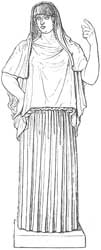Vesta

One of the great Roman divinities, identical with the Greek Hestia both in name and import. She was the goddess of the hearth, and therefore inseparably connected with the Penates, for Aeneas was believed to have brought the eternal fire of Vesta from Troy, along with the images of the Penates; and the praetors, consuls, and dictators, before entering upon their official functions, sacrificed not only to the Penates, but also to Vesta at Lavinium. 1
In the ancient Roman house, the hearth was the central part, and around it all the inmates daily assembled for their common meal (coena, κοινή), and every meal thus taken was a fresh bond of union and affection among the members of a family, and at the same time an act of worship of Vesta combined with a sacrifice to her and the Penates.2 Every dwelling house therefore was, in some sense, a temple of Vesta,3 but a public sanctuary united all the citizens of the state into one large family. This sanctuary stood in the Forum, between the Capitoline and Palatine hills, and not far from the temple of the Penates.4 That temple was round with a vaulted roof, like the impluvium of private houses, so that there is no reason to regard that form as an imitation of the vault of heaven5 The goddess was not represented in her temple by a statue, but the eternal fire burning on the hearth or altar was her living symbol, and was kept up and attended to by the Vestals, her virgin priestesses. As each house, and the city itself, so also the country had its own Vesta, and the latter was worshiped at Lavinium, the metropolis of the Latins, where she was worshiped and received the regular sacrifices at the hands of the highest magistrates. The goddess herself was regarded as chaste and pure like her symbol, the fire, and the Vestals, who kept up the sacred fire, were likewise pure maidens.
As regards her worship, it is stated, that every year, on the 1st of March her sacred fire, and the laurel tree which shaded her hearth, were renewed,6 and that on the 15th of June her temple was cleaned and purified. The dirt was carried into an angiportus behind the temple, which was locked by a gate that no one might enter it.7 The day on which this took place was a dies nefastus, the first half of which was thought to be so inauspicious, that the priestess of Juno was not allowed to comb her hair, to cut her nails, or to approach her husband, while the second half was very favorable to contracting a marriage or entering upon other important undertakings. A few days before that solemnity, on the 9th of June, the Vestalia was celebrated in honor of the goddess, on which occasion none but women walked to the temple, and that with bare feet. On one of these occasions an altar had been dedicated to Jupiter Pistor.8
❧
Iconography
A statue of the goddess, the so-called Vesta Giustiniani at Rome, portrays her as a stern woman dressed in a long robe and with her head veiled. Her right hand rests at her side and in her left hand she presumably holds a scepter.
References
Notes
- Virgil. Aeneid ii, 296 ff.; x, 259; v, 744; Macrobius. Saturnalia iii, 4.
- Ovid. Fasti vi, 305; Virgil. Georgics, iv, 384; Servius on Virgil's Aeneid i, 734.
- Augustine. City of God iv, 11.
- Dionysius, ii, 65.
- Ovid. Fasti vi, 269 ff., 282; Plutarch. Numa, 11.
- Macrobius. Saturnalia i, 12; Ovid. Fasti iii, 143.
- Ovid. Fasti vi, 227 ff.; Festus, i, 344 (ed. Müller).
- Ovid. Fasti vi, 3.50; comp. Hartung, J.A. Die Religion der Römer. Vol. 2, p. iii ff.
Sources
- Aken, Dr. A.R.A. van. (1961). Elseviers Mythologische Encyclopedie. Amsterdam: Elsevier.
- Smith, William. (1870). Dictionary of Greek and Roman Biography and Mythology. London: Taylor, Walton, and Maberly.
This article incorporates text from Dictionary of Greek and Roman Biography and Mythology (1870) by William Smith, which is in the public domain.